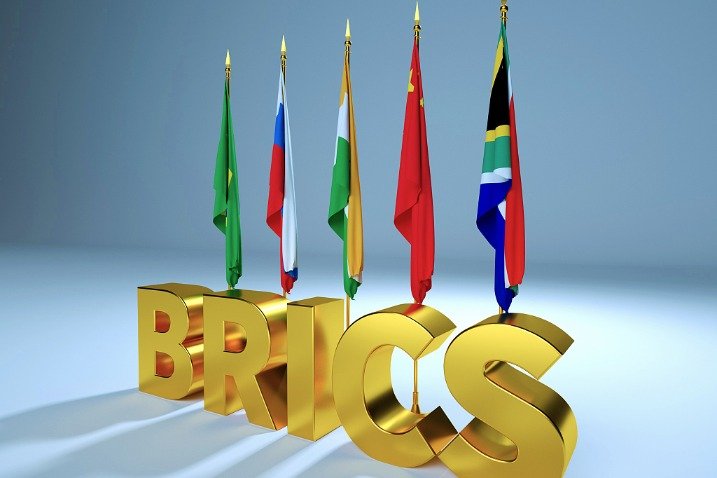
Navigating Transition: The Role of Global South in the New Economic Landscape.
The Global South faces a pivotal economic transition. With growing BRICS cooperation, rising US tariffs, and regional integration efforts like AfCFTA, developing economies must harness resources, enhance trade, and build financial resilience through collective strategy and South-South solidarity.
The economic evolution of Global South nations, particularly within the context of the BRICS alliance and recent US trade policies. It discusses the potential for increased cooperation among these nations as they respond to changing global dynamics.
In 2023, the geopolitical landscape is witnessing a significant shift. As traditional powerhouses face economic hurdles, the Global South stands on the precipice of change, wielding a wealth of natural resources yet grappling with uneven economic dividends. A recent BRICS conference in Brazil highlighted the urgent need for enhanced cooperation and strategies among these nations to leverage their potential.
Understanding the Current Economic Landscape of the Global South
The Global South is rich in resources. Yet, many of these countries struggle to fully capitalize on what they possess. Why is that? The answer lies in a complex web of challenges and opportunities. This section explores the distribution of resources, the hurdles in maximizing economic benefits, and the role of the BRICS alliance in fostering collaboration.
Distribution of Resources Across Global South Economies
To understand the economic landscape, one must first examine how resources are distributed. The Global South, which includes countries in Africa, Latin America, and parts of Asia, holds a significant portion of the world’s natural resources. These include minerals, oil, and agricultural products. However, the wealth generated from these resources often does not translate into economic prosperity for the local populations.
- Natural Resources: Countries like Brazil and South Africa are rich in minerals and agricultural land.
- Oil Reserves: Nations in the Middle East and parts of Africa have vast oil reserves.
- Human Capital: The Global South is home to a young and dynamic workforce, ready to contribute to economic growth.
Despite this abundance, many countries face significant challenges in harnessing these resources effectively. The question remains: how can they turn ownership into economic dividends?
Challenges in Maximizing Economic Dividends
Maximizing economic dividends from resources is no easy feat. Several factors contribute to this struggle:
- Lack of Infrastructure: Many countries lack the necessary infrastructure to extract and process resources efficiently.
- Political Instability: Frequent changes in government and policy can deter investment and disrupt economic activities.
- Trade Barriers: Tariffs and trade restrictions, particularly from developed nations, can limit market access.
Dr. Yaraslav Savik, a leading expert in the BRICS Plus economic alliance, emphasizes the need for greater coordination among these economies. He states,
“Regionalism is crucial for global south solidarity during economic uncertainty.”
This highlights the importance of collaboration in overcoming these challenges.
The Role of the BRICS Alliance
The BRICS alliance, which includes Brazil, Russia, India, China, and South Africa, plays a pivotal role in fostering economic collaboration among Global South countries. Recently, nearly 30 countries have expressed interest in joining BRICS, indicating a growing desire for collective economic presence.
At a recent conference in São Paulo, Brazil, discussions centered around creating a coordinated response to U.S. tariffs. The focus was on enhancing South-South trade and developing a new financial architecture. This is crucial, as trade intensity in regions like South America is currently below its potential.
- New Memberships: While some countries like Indonesia have successfully joined, the BRICS alliance is cautious about expanding its core membership.
- Alternative Payment Mechanisms: Brazil’s President Lula Da Silva is advocating for alternative financial instruments to facilitate South-South cooperation.
- Resource Platforms: The idea of establishing resource platforms similar to OPEC+ could help in better utilizing the wealth of resources.
These initiatives aim to enhance local currency transactions and improve financial cooperation among member countries. The potential for increased collaboration is significant, especially in light of the pressures exerted by U.S. foreign economic policy.
The Global South stands at a crossroads. With abundant resources and a youthful workforce, the potential for economic growth is immense. However, challenges such as infrastructure deficits, political instability, and external trade barriers must be addressed. The BRICS alliance offers a promising avenue for collaboration, but it requires a strategic roadmap for trade liberalization and economic integration.
As the Global South navigates these complexities, the emphasis on regionalism and solidarity becomes increasingly vital. The future of these economies may depend on their ability to work together, turning challenges into opportunities for growth and prosperity.
US Trade Policies and Their Impact on Global South Economies
The impact of US trade policies, particularly tariffs, on emerging markets in the Global South is profound. These tariffs, often seen as a protective measure, can lead to significant economic challenges for developing nations. The average tariff increase of around 10% for affected economies has raised concerns about financial stability and inflation.
Effects of US Tariffs on Emerging Markets
US tariffs have created a ripple effect across the Global South. Countries that rely heavily on exports to the US face immediate challenges. For instance, Brazil, with its manageable tariff increase, is less affected than Asian economies like China, which are deeply integrated into global supply chains. This disparity raises questions: How can countries like Brazil leverage their resources effectively? What strategies can they adopt to mitigate the impact of these tariffs?
- Exchange Rate Instability: Recent trends indicate that US tariffs have led to exchange rate instability in various countries. This instability can deter foreign investment and complicate trade agreements.
- Inflationary Pressures: The correlation between tariff increases and inflation is well-documented. Economies in the Global South may see inflation rates rise by 2-5% due to these tariffs, affecting the purchasing power of citizens.
Short-term and Long-term Responses to Tariff Impacts
In response to these challenges, countries in the Global South must consider both short-term and long-term strategies. Short-term responses may include:
- Adjusting Trade Policies: Countries can seek to renegotiate trade agreements or explore new markets to offset losses from US tariffs.
- Enhancing Local Production: By boosting local industries, nations can reduce reliance on imports and create jobs.
Long-term strategies might involve:
- Strengthening Regional Cooperation: Initiatives like the African Continental Free Trade Area can foster solidarity and economic resilience.
- Developing Alternative Financial Mechanisms: As Dr. Yaraslav Savik suggests, creating alternative payment systems can help reduce dependency on the US dollar and enhance trade among Global South nations.
Financial Market Volatility and Inflationary Pressures
The financial markets in emerging economies are particularly vulnerable to the effects of US trade policies. Volatility can lead to unpredictable investment climates, making it difficult for businesses to plan for the future. This uncertainty can stifle growth and innovation.
Moreover, inflationary pressures can erode consumer confidence. When prices rise, purchasing power diminishes. This situation creates a cycle of economic strain that can be hard to break. As one expert noted,
“Western protectionism can become a blessing in disguise, prompting greater trade resilience in the global south.”
This perspective suggests that while tariffs pose challenges, they may also encourage countries to innovate and adapt.
In summary, US trade policies significantly impact the Global South. The effects of tariffs are multifaceted, leading to exchange rate instability, inflationary pressures, and financial market volatility. Countries must respond strategically, balancing immediate needs with long-term goals. The path forward may involve greater regional cooperation and innovative financial solutions. As the Global South navigates these challenges, the potential for resilience and growth remains. The ongoing dialogue among nations will be crucial in shaping a more stable economic future.
The Path Forward: Enhancing South-South Cooperation
In recent discussions, the focus has shifted towards enhancing cooperation among nations in the Global South. This is not just a trend; it’s a necessity. The challenges faced by these economies are significant, yet the potential for growth is immense. How can these nations capitalize on their resources? What strategies can be implemented to boost trade and investment? These questions are at the forefront of the dialogue.
Strategies for Increasing South-South Trade and Investment
To foster greater economic collaboration, several strategies can be employed:
- Enhancing Trade Agreements: Countries in the Global South should prioritize creating and strengthening trade agreements. This can reduce tariffs and encourage smoother trade flows.
- Investment in Infrastructure: Developing infrastructure is crucial. Improved roads, ports, and communication networks can facilitate trade.
- Promoting Local Industries: Supporting local businesses can increase self-sufficiency and reduce reliance on external markets.
- Leveraging Technology: Utilizing technology can streamline processes and improve efficiency in trade.
Dr. Yaraslav Savik, a leading expert in the BRICS Plus economic alliance, emphasizes that “now is a unique opportunity to encourage greater intra-regional trade across the Global South.” This sentiment resonates with many leaders who recognize the potential for collaboration.
The Importance of Regional Integration Projects
Regional integration is a vital component of enhancing cooperation. Projects like the African Continental Free Trade Area (AfCFTA) are prime examples of how nations can work together. The AfCFTA aims to create a single market for goods and services across Africa, which can significantly boost intra-African trade.
Why is this important? High tariffs from Western economies often hinder trade. By integrating regionally, countries can counteract these effects. This approach not only fosters economic solidarity but also enhances resilience against external pressures.
Moreover, regional integration can lead to:
- Increased Market Access: Businesses can access larger markets, leading to economies of scale.
- Shared Resources: Countries can pool resources for mutual benefit, enhancing overall economic stability.
- Stronger Political Alliances: Economic ties can lead to stronger political relationships, fostering peace and cooperation.
Envisioning the Future of BRICS
The BRICS alliance, comprising Brazil, Russia, India, China, and South Africa, is at a crossroads. With nearly 30 countries expressing interest in joining, the future looks promising. However, the current leadership emphasizes stability among existing members before expanding further.
What does this mean for the Global South? It suggests a cautious but optimistic approach to collaboration. As Dr. Savik notes, the need for a coherent roadmap for trade liberalization is pressing. Without a strategic plan, the potential for growth may remain untapped.
Additionally, the geopolitical climate, marked by U.S. tariffs, may inadvertently serve as a catalyst for greater economic cooperation. Countries are beginning to realize that working together can mitigate the adverse effects of external pressures.
The discussions surrounding South-South cooperation highlight a critical juncture for the Global South. By identifying strategies to enhance trade and investment, emphasizing regional integration, and envisioning a robust future for BRICS, these nations can forge a path forward. The potential for collaboration is vast, and the time to act is now. As the world becomes increasingly interconnected, the Global South must seize this opportunity to strengthen its economic ties and build a resilient future.
TL;DR: The Global South, represented by the BRICS alliance, is presented with unique opportunities and challenges amid evolving global trade dynamics and US tariff policies. This post explores the essential strategies for economic cooperation and regional integration to navigate these changes.
TradeStrategies, RegionalCooperation, USTariffsImpact, GlobalSouthEconomies, BRICSAlliance, EconomicCooperation
#GlobalSouthEconomies, #USTariffsImpact, #TradeStrategies, #RegionalCooperation, #EconomicCooperation, #BRICSAlliance,#GlobalSouth, #BRICS, #EconomicTransition, #SouthSouthCooperation, #USTariffs, #EmergingMarkets, #RegionalIntegration, #TradePolicy, #EconomicResilience, #BRICSExpansion

